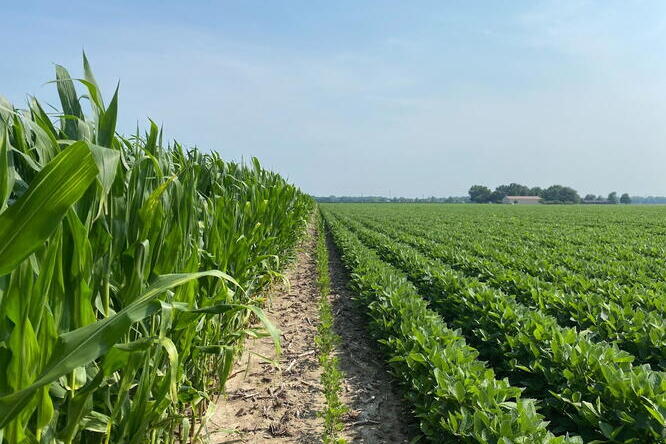2025-06-23 イリノイ大学アーバナ・シャンペーン校

Credit: Ziyi Li
<関連情報>
- https://aces.illinois.edu/news/corn-after-soy-new-study-quantifies-rotation-benefits-and-trade-offs
- https://www.sciencedirect.com/science/article/abs/pii/S0167880925002713
アメリカ中西部におけるトウモロコシ連作とダイズ・トウモロコシ輪作体系の比較: 作物収量、養分損失、土壌有機炭素の変化のトレードオフ Comparing continuous-corn and soybean-corn rotation cropping systems in the U.S. central Midwest: Trade-offs among crop yield, nutrient losses, and change in soil organic carbon
Ziyi Li, Kaiyu Guan, Wang Zhou, Bin Peng, Emerson D. Nafziger, Robert F. Grant, Zhenong Jin, Jinyun Tang, Andrew J. Margenot, DoKyoung Lee, Carl J. Bernacchi, Evan H. DeLucia, Ignacio Ciampitti, Tongxi Hu, Lexuan Ye, Jessica Till, Mengqi Jia
Agriculture, Ecosystems & Environment Available online: 7 June 2025
DOI:https://doi.org/10.1016/j.agee.2025.109739
Highlights
- Soybean-corn boosts corn yield over continuous-corn by increasing nitrogen mineralization.
- Soybean residue accelerates SOC loss but reduces N₂O and NH₃ emissions under normal N fertilizer rates.
- Soybean-corn rotation increases economic returns at low N rates but loses this advantage at higher rates.
- Nitrogen fertilizer rate shifts the trade-offs in yield, SOC, and nitrogen losses between soybean-corn and continuous-corn systems.
Abstract
Soybean-corn (S-C) is the most common cropping sequence in the U.S. Midwest, known for improving corn yield compared with continuous corn (C-C). However, the underlying mechanisms and impacts on crop productivity, environmental sustainability, and economic returns are not fully understood. Using the agroecosystem model, ecosys, we simulated S-C and C-C systems under different nitrogen (N) fertilizer application rates, demonstrating good performance in capturing N rate-corn yield responses and CO2 fluxes across 10 Illinois sites. Our analysis revealed: (1) under normal N rates (151 kg N/ha), soybean residues contributed an average of 36% less carbon but 47% more N than corn, resulting in higher early spring soil temperatures and net mineralization in the subsequent corn year, boosting corn yields for S-C relative to C-C. This yield benefit was reduced with higher N rates. (2) S-C reduced soil organic carbon (SOC) relative to C-C due to faster decomposition of soybean residue under normal N rates, but mitigated nitrous oxide (N2O) and ammonia (NH3) emissions. Effects on N leaching varied, with reductions during soybean years and increases in the following corn years. N rates shifted the relative differences of SOC and N losses between S-C and C-C. (3) Economically, S-C provided $1133/ha higher returns than C-C at low N rates (50 kg N/ha) under typical market conditions (soybean: $410/Mg, corn: $178/Mg, and N fertilizer: $193/Mg). However, this advantage diminished at higher N rates due to increased costs and smaller corn yield gains, especially under extreme market scenarios with high corn prices and lower soybean-to-corn and fertilizer-to-corn price ratios. These findings highlight trade-offs among crop yield, nutrient losses and soil carbon change by adopting S-C in the U.S. central Midwestern cropping systems.



